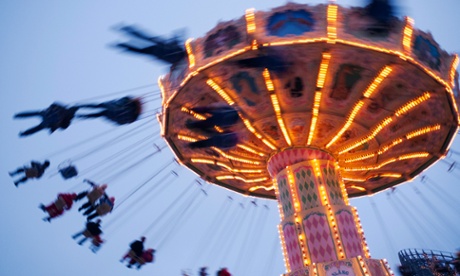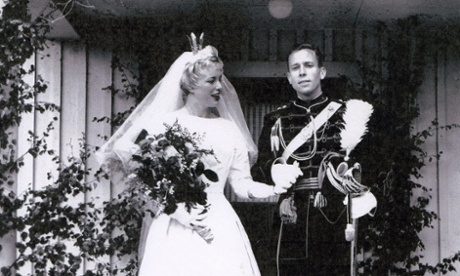
In a spin: on the chair-o-plane at the theme park. Photograph: Corbis
Vendela Vida, The Guardian, September 21, 2015
You would think we’d never been on a train before. My children and I are standing on platform two of the small station in Mellerud, Sweden, taking pictures of each other, and of my Aunt Gerd and Uncle Cees, who are seeing us off. When the train to Gothenburg arrives, we board and theatrically wave goodbye through the windows. Can you blame us for our excitement? We’re going to Liseberg, Scandinavia’s largest amusement park. My mother used to go there when she was little, and I used to go there when I was young. My kids have been hearing about it for years.
I was born and raised in America, but my mother was raised on a farm outside Mellerud. When I was growing up in San Francisco she would take me and my sister to Sweden in the summer to show us how she grew up. So I’ve now taken my children from San Francisco to Sweden so they can see how I passed my childhood summers. We’ve just spent a week with my cousins and their families, sleeping in lakeside cabins. We’ve gone swimming and canoeing and have picked blueberries and chanterelle mushrooms because this is what my mother did during her childhood summers and, consequently, what I did in mine.
On the train ride from Mellerud to Gothenburg, I tell my kids about how my mother’s father, Birger, would sometimes send my mother and Gerd to stay with relatives. The girls were too young to read station signs, so Birger would instruct them to count the stops on their fingers, and get off at the seventh station. My kids want to do this, too, but I don’t know how many stops there are to Gothenburg, and my oldest, who is nine, can read.
My pulse quickens as we near the entrance to Liseberg, which is framed by tall castle-like towers. It’s almost 8pm and the park is filled with Swedish families with pushchairs who have spent the day there, and teenagers and adults who are just arriving. A few women are holding Toblerone bars the length of their legs, and many men carry enormous stuffed animals – some versions of the park’s mascot, a rabbit with two buck teeth and a polka-dot bow tie. These are prizes they’ve won or purchases they’ve made. I see a blond man pushing a stroller and taking a bite of pink candy floss from a bag that’s been passed on to him from his now-screaming child. The sun hasn’t set yet and won’t until near midnight.
We decide to ride the Liseberg Wheel first, and as we follow arrows to the enormous Ferris wheel we pass well-manicured areas of green grass with manmade streams. “This is so nice!” the kids say, and I agree. In contrast, the American amusement parks we’re used to provide zero shade and as much asphalt as possible. But there is civility here as we wait in line for the Ferris wheel and civility as we’re directed to our cab and proceed to spin slowly up to the top and look down on Gothenburg, with its white buildings and red roofs.
We pass on the frightening-looking AtmosFear – billed as the tallest free-fall attraction in Europe. Every six minutes the collective screams of everyone on the ride pierce the tranquil evening. We play a game in which both my kids aim a water gun at a target to make their cars propel forward across the track. Regardless of the fact that there’s one clear winner, they’re both given black and red buttons that say Jag vann (“I won”), with the Liseberg logo at the bottom. I help them pin the buttons to their T-shirts and then take them to a corner of the park that others might ignore or pass over without giving much attention. “This is where it happened,” I tell them. “This is where my cousin vomited after we rode the rollercoaster four times in a row 31 years ago.” “Really?” my son says. “Here?” My daughter takes a photograph.

Together forever: Gerd and Cees, Vendela’s aunt and uncle, on their wedding day. They met at the park in 1960.
I buy them ice-cream cones and we sit at a picnic table near a covered but open-air dance floor. A Swedish band plays a John Fogerty song, “Rockin’ All Over the World”, and the circular floor is packed. Old couples dance, young couples dance, parents twirl young children, and people I’m not sure were couples before stepping on to the dance floor sway in very close proximity. My son, who cannot resist moving when he hears music, is bouncing up and down on the picnic bench.
I tell my children the story of how Aunt Gerd met her husband on the Liseberg dance floor in 1960. My mother and Gerd were in their sundresses listening to the band. Cees was a young Dutch soldier visiting Gothenburg on his leave. He and his friend were walking around Liseberg when they heard Glenn Miller’s music being played. Cees loved Glenn Miller, and they made their way to the floor. The men had to buy tickets for each dance (three dances for one krona). He and Gerd danced for three songs. Then he bought more tickets. They’ve been married for 54 years.
My children now have remnants of their ice cream in their hair and on their shirts. We look at the dancers before us and try to pick out which of them might fall in love tonight. A young man in red trousers steals a kiss from a woman in a sundress and she kisses him back. “Look, Mama,” my kids say to me. “The man in the red trousers has the same button we do!” He does. He’s wearing one of the buttons that tell the world – or at least the dance floor – that he’s won at Liseberg.
For more information, go to liseberg.com. British Airways flies from Heathrow to Gothenburg from £86 return
Vendela Vida’s new novel is The Diver’s Clothes Lie Empty (Atlantic Books, £14.99). To order a copy for £11.99, including UK p&p, go to bookshop.theguardian.com
This article originally appeared on guardian.co.uk
This article was written by VENDELA VIDA from The Guardian and was legally licensed through the NewsCred publisher network.
![]()